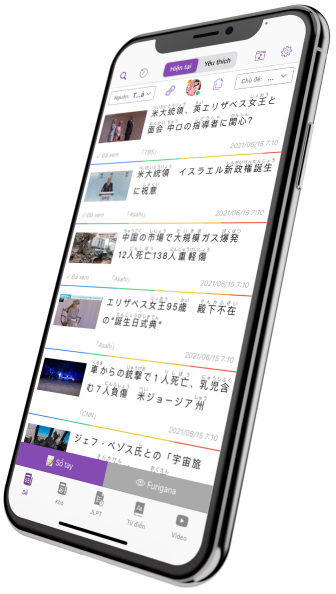
If you want to take the JLPT mock tests, you can try TODAI Japanese below! There are full answers and explanations for every question!
1. Why should you take the JLPT N3 Exam?
If you are looking for a job or planning to pursue education in Japan, then your JLPT scores will come in handy. JLPT certifications can also be advantageous when immigrating to Japan, as those who have passed the N2 and N1 qualify for preferential treatment.
While N3 doesn't offer the same advantages, it's a great way to gauge your everyday Japanese skills and bridge the gap between easier and harder JLPT levels.
2. What does the N3 Exam test on?
In general, the JLPT N3 Exam is an exam for intermediate-level speakers. The JLPT N3 tests you on the ability to understand Japanese used in everyday situations to a certain degree. This includes having no difficulty in:
-
Reading and understanding materials concerning specific everyday topics
-
Grasping summary information such as newspaper headlines
-
Reading and fairly understanding slightly difficult writings encountered in everyday situations
-
Listening and comprehending everyday conversations spoken at near-natural speed, following their contents, and grasping the relationships among the people involved
3. How many sections are on the N3 Exam?
To effectively prepare for the exam, understanding the test format is crucial. The JLPT N3 Exam comprises three primary sections, each evaluating distinct facets of the Japanese language.
|
Section |
Question types |
|
1. Language Knowledge (Vocabulary) |
– Kanji reading – Orthography – Contextually-defined expressions – Paraphrases – Usage |
|
2. Language Knowledge (Grammar) and Reading |
– Sentential grammar 1 (selecting grammar form) – Sentential grammar 2 (sentence composition) – Text grammar – Comprehension (short passages) – Comprehension (mid-length passages) – Comprehension (long passages) |
|
3. Listening |
– Task-based comprehension – Comprehension of key points – Comprehension of general outline – Verbal expressions – Quick response |
4. What is and is not covered in the JLPT N3 Exam?
To excel in all three sections, you'll need to command roughly 3,700 vocabulary words and 650 kanji characters. While this might seem like a daunting task, you've already covered about 1,500 words and 300 kanji from the N5 and N4 levels, putting you halfway there! The N3 Exam vocabulary and kanji encompass fundamental nouns and verbs from N4 and N5, along with more advanced terms necessary for comprehending slightly complex written materials like newspaper headlines.
Moreover, you should be well-versed in common grammar points, including particle usage, formal and informal verb and adjective conjugations for past and present tenses, and sentence structures. Before tackling the test, you should feel at ease reading and writing medium-length sentences and passages.
It's worth noting that the JLPT Exam doesn't assess speaking skills, meaning that learners uncomfortable with spoken Japanese can theoretically pass as long as they've mastered the N3 Exam's vocabulary, kanji, and grammar. However, it's essential to remember that conversational abilities are still vital for daily life if you're seriously considering a future in Japan!
For students who already have a foundation in kanji, it typically takes around 900 hours to prepare.
5. How to Prepare
Mastering Kanji and Vocabulary
As you progress from the N5 and N4 levels to N3-level kanji, it becomes increasingly important to familiarize yourself with kanji radicals and gain a deeper understanding of the individual components within each kanji character. This approach not only facilitates more efficient kanji memorization but also enhances your ability to discern the meanings of words.
Personally, I highly recommend using TODAI Easy Japanese as a valuable resource for mastering JLPT N3 Kanji and vocabulary. This application not only aids in expanding your Japanese vocabulary but also provides the opportunity to put your knowledge into practice by reading Japanese news articles. Furthermore, you can save new vocabulary in your personal notebook and reinforce your learning through flashcards practice at your convenience.
Mastering Grammar
For grammar, I used two textbooks: 日本語能力試験長躯全対策文法 N3 A and B (Nihongo noryouku shIken Cyoukuzen Taisaku Bunpou N3 A and B). All two textbooks include summaries of N3 grammar. They also have English translations and examples, which makes them a really good tool for individual study
The downside lies in the lack of practice sessions, so I decided to make at least 5 sentences based on each grammar I just learned.
Reading and Listening
If you are studying alone, reading and listening could be the hardest part of learning in the JLPT. Even though there are books dedicated to these two test sections, you cannot really digest them if you haven’t learned the essential vocabulary and grammar.
Why? Because the JLPT reading and listening section are an accumulation of everything you learned: grammar, vocabulary and kanji. The key is getting used to taking them.
Make reading become your habit is a good way to improve your Japanese reading, take more JLPT mock tests can help you become more familiar with JLPT listening. Moreover, you can watch video with bilingual subtitles to improve your Japanese listening!
6. Advice I Would Give to Myself (And Everyone) to Pass the JLPT N3
One of the most important parts of the JLPT, or any standardized test, is being familiar with the test format. Here are some of the things I regret I did (or didn’t do).
Do: Regularly take extra practice tests.
You will become more familiar with the questions and the format, and as a result, you will be able to identify your weak areas and concentrate your improvement efforts there. Additionally, you can print the answer sheet and attempt to complete it in pencil if you wish to practice the exam in a real-world setting. You will have a bigger advantage when taking the actual test because of it.
Do: Take your watch to the testing area.
You can take the test more calmly if you can see the time and measure it. It is crucial to be aware of how much time is left on the test because there is a propensity to spend too much time reading and analyzing questions when you simply needed to skim them to answer the questions.
Do: Get enough sleep the previous night.
People frequently experience anxiety the day before the exam, and they sacrifice sleep to over-prepare. Sadly, I was one of those who fall victim to this notion. I stayed up till two in the morning studying and got up at seven. I was struggling to stay awake the whole time. Make sure to get some rest the night before and have faith in your abilities.
👉 Follow TODAI Japanese to learn Japanese better and know more about the latest information!































Login to comment